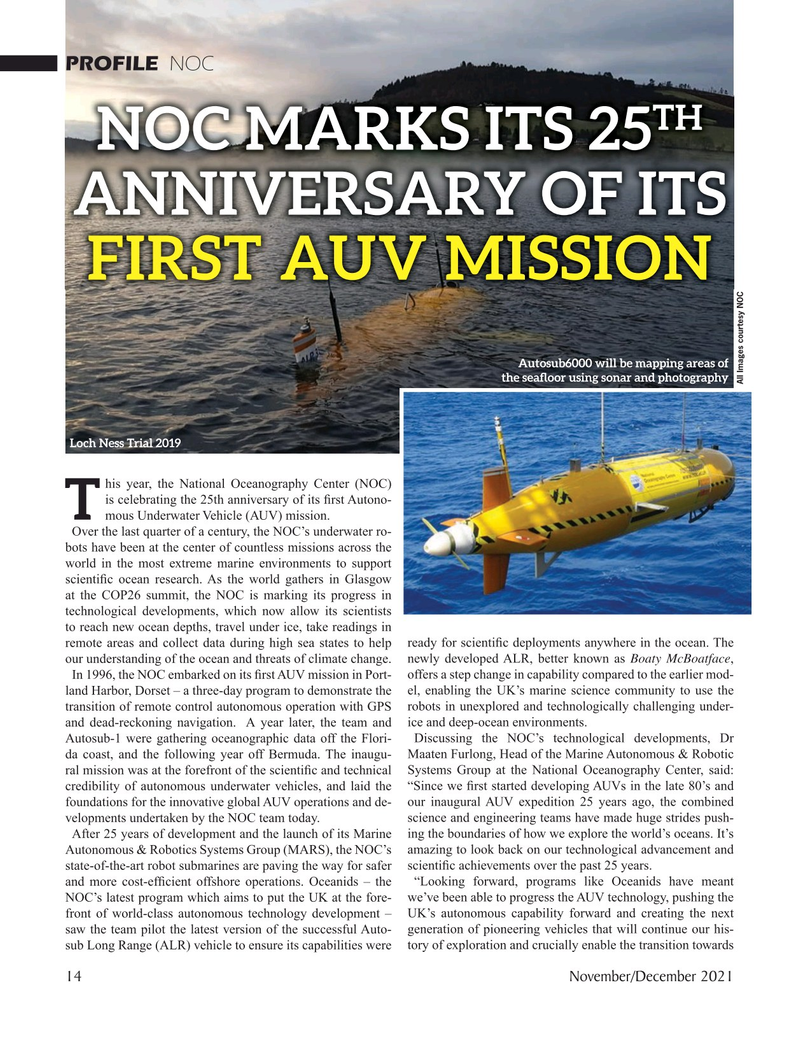
Page 14: of Marine Technology Magazine (November 2021)
Ocean Observation: Gliders, Buoys & Sub-Surface Networks
Read this page in Pdf, Flash or Html5 edition of November 2021 Marine Technology Magazine
PROFILE NOC
TH
NOC MARKS ITS 25
ANNIVERSARY OF ITS
FIRST AUV MISSION
Autosub6000 will be mapping areas of the sea? oor using sonar and photography
All Images courtesy NOC
Loch Ness Trial 2019 his year, the National Oceanography Center (NOC) is celebrating the 25th anniversary of its ? rst Autono-
T mous Underwater Vehicle (AUV) mission.
Over the last quarter of a century, the NOC’s underwater ro- bots have been at the center of countless missions across the world in the most extreme marine environments to support scienti? c ocean research. As the world gathers in Glasgow at the COP26 summit, the NOC is marking its progress in technological developments, which now allow its scientists to reach new ocean depths, travel under ice, take readings in remote areas and collect data during high sea states to help ready for scienti? c deployments anywhere in the ocean. The our understanding of the ocean and threats of climate change. newly developed ALR, better known as Boaty McBoatface,
In 1996, the NOC embarked on its ? rst AUV mission in Port- offers a step change in capability compared to the earlier mod- land Harbor, Dorset – a three-day program to demonstrate the el, enabling the UK’s marine science community to use the transition of remote control autonomous operation with GPS robots in unexplored and technologically challenging under- and dead-reckoning navigation. A year later, the team and ice and deep-ocean environments.
Autosub-1 were gathering oceanographic data off the Flori- Discussing the NOC’s technological developments, Dr da coast, and the following year off Bermuda. The inaugu- Maaten Furlong, Head of the Marine Autonomous & Robotic ral mission was at the forefront of the scienti? c and technical Systems Group at the National Oceanography Center, said: credibility of autonomous underwater vehicles, and laid the “Since we ? rst started developing AUVs in the late 80’s and foundations for the innovative global AUV operations and de- our inaugural AUV expedition 25 years ago, the combined velopments undertaken by the NOC team today. science and engineering teams have made huge strides push-
After 25 years of development and the launch of its Marine ing the boundaries of how we explore the world’s oceans. It’s
Autonomous & Robotics Systems Group (MARS), the NOC’s amazing to look back on our technological advancement and state-of-the-art robot submarines are paving the way for safer scienti? c achievements over the past 25 years.
and more cost-ef? cient offshore operations. Oceanids – the “Looking forward, programs like Oceanids have meant
NOC’s latest program which aims to put the UK at the fore- we’ve been able to progress the AUV technology, pushing the front of world-class autonomous technology development – UK’s autonomous capability forward and creating the next saw the team pilot the latest version of the successful Auto- generation of pioneering vehicles that will continue our his- sub Long Range (ALR) vehicle to ensure its capabilities were tory of exploration and crucially enable the transition towards 14 November/December 2021
MTR #8 (1-17).indd 14 11/22/2021 11:34:01 AM

 13
13

 15
15
